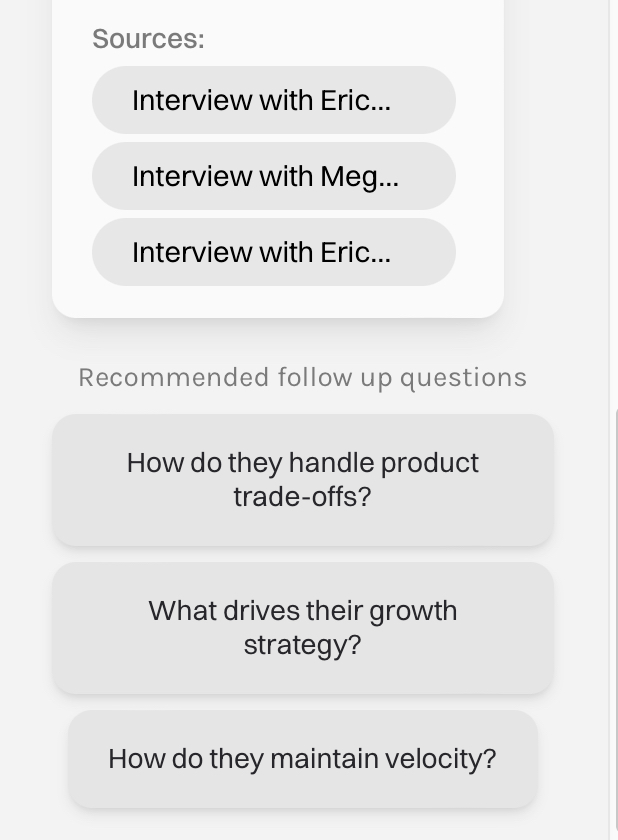
Was this newsletter forwarded to you? Sign up to get it in your inbox.
Today, we’re launching a new essay format on Every: Extendable Articles.
Extendable Articles include a chat bot that lets you talk to the content that you’re reading. But there’s a twist:
In an Extendable Article, we make available all of the source material—original interview recordings and transcripts, YouTube videos, news stories, articles, and more—that the writer used to put the piece together. So you don’t just get the writer’s perspective—you can chat with all of the information they used to inform it.
It looks like this:
When you’re reading an Extendable Article, you can ask it anything you want, such as to summarize the article’s thesis or where a particular fact or quote came from. It also suggests default questions to help you easily find additional pieces of information or new ideas. We’ve worked hard to provide default questions that let you go beneath the surface. You can ask things like:- What was surprising or interesting in the interviews that didn’t make it into the finished article?
- If you read between the lines, what can you tell from the interviews that the interviewees never explicitly said?
- What do you think is the perspective of the writer from the interviews?
When you ask a question, it will return a detailed answer:
It will also reference the relevant original sources and recommend follow-up questions:You can even browse a list of all of the sources used to create the article and watch the original interviews conducted by the writer on YouTube:
We think Extendable Media is exciting because it allows both writers to tell great stories and readers to form their own opinions by interacting with the source material if they want to.And we think the time for this is now.
The internet allows publications like ours to include unlimited context alongside a narrative without disrupting its flow—and at no extra cost. AI can make this context discoverable and meaningful.
If you’re curious, you can try Extendable Articles right now in the deep dive we just published on Ramp, “The Religion of Ramp,” by Evan Armstrong. We’ve included all of the interviews Evan did with Ramp’s team, as well as the articles and videos he used as background research.
If you’re interested in the back story, here’s a little bit more about why we did it.
How and why Extendable Articles happened
When you write, you always have to leave something important out.
Stories are created by subtraction. They start as an endless ocean of facts and ideas. The writer’s task is to find and follow the currents of narrative in this ocean, and channel them into a story. This is a good thing: Not everyone needs to explore the ocean, but we should all know what’s out there.
But the subtraction process that creates a story has a downside: It can never be entirely objective. Decisions have to be made about what to include and what to cut. And, invariably, there is a debate about what those decisions should be.
Rightly or wrongly, people don’t trust those decisions right now. Accusations of bias in the media run rampant from all sides, but there’s no easy solution because omission is an inevitable part of narrative.
I’ve felt this acutely while running Every. I’ve spent countless hours debating with Evan and Kate, and other writers and editors on the team, about how to write stories, and what to include and what to cut. We’re not trying to be objective—people read Every because our writers come with their own perspectives. But we always try to be fair-minded, nuanced, and curious, and that’s a standard that’s incredibly difficult to get right every time.
We’ve made mistakes, and I think every other media organization and writer would say the same.
Eighteen months ago, I realized that technology was changing this equation. Before, research and storytelling were always inextricably bundled together. But because AI can now tell stories, pure research—without an accompanying story—can be useful raw material for any end user.
I wrote this:
“Publications should still write their own version of the narrative given the facts they’ve gathered. But they could also expose the research underlying those facts, and allow readers to interrogate that research with AI.”
I thought it might be possible for any publication to incorporate a chat experience to help readers get more out of their content:
“Imagine a world in which you can click a button next to a news story and see all of the interview transcripts, Google searches, editorial conversations, and more that were used to create the story. Based on this source information, news organizations could make chatbots available that could rewrite the canonical story for you with more details—or answer key questions you might have that went unaddressed in the original. These experiences, when well-created, might constitute new content formats in and of themselves and will require craft to create.”
At the time I wrote this, AI was still not good enough to make this a reality. Context windows weren’t large enough, and the experience just wasn’t going to be reliably good. But that’s changed over the last year.
So we decided to build it.
With Extendable Articles, we can publish stories that have a valuable perspective on the world—and you can form your own opinions from the research we’ve done.
Of course, this doesn’t solve every problem. For example, much of what forms a writer’s worldview isn’t source material for a particular piece—it may come from books or conversations over many years—and it’s difficult to include those kinds of sources in a format like this.
But we think it’s an important step in the right direction. And this is just the beginning.
So try it out. Read the perspective in the main story, and explore the transcripts and articles that formed it in their entirety. Let us know what you discover—we’re as curious as you are.
At Every we’re obsessed with what comes next, and we know that’s what you care about, too.
We hope Extendable Articles become one more tool to see what’s beyond the horizon—together.
Dan Shipper is the cofounder and CEO of Every, where he writes the Chain of Thought column and hosts the podcast AI & I. You can follow him on X at @danshipper and on LinkedIn, and Every on X at @every and on LinkedIn.
We also build AI tools for readers like you. Automate repeat writing with Spiral. Organize files automatically with Sparkle. Write something great with Lex.




.33.56_PM.png)

.png)
Comments
Don't have an account? Sign up!
Such a cool new feature, well done team.
@Tintin thank you! glad to see you back!
This is a brilliant idea. What a way to use the power of AI to change the reading and writing process. It would be neat to include a brief and a longer version by default. Also neat would be to supply the AI with versions of the article (drafts) so that it can also comment on the writing process (such as the original opening paragraph of the piece, say). Again, wonderful idea.
@federicoescobarcordoba thank you!! yeah these are great ideas. I love the idea of exposing the drafts.
we'll keep tweaking it over time. thanks for sharing!
I agree this is a very interesting idea. And yet... I can't imagine myself actually using the feature beyond initial novelty. Maybe that will change if a particularly compelling or challenging (to my worldview) article comes along, or if the actual experience ends up being compelling in ways I can't anticipate. I suspect (sadly, perhaps pessimistically) that it won't do much to actually change more minds or make people more confident in the stories told (as somewhat suggested in the inspiration for creating this). But I love the experimentation and would love even more to be surprised by the results! I hope (and expect) that you have analytics already built in that might help evaluate its impact.
@Oshyan I agree with your assessment. I think it would be really interesting to do this extended media again but take on a highly divisive topic: AI in warfare, bioengineering, DEI, etc. If I have a take that basically everyone disagrees with, maybe instead of arguing with me in the comments they'll argue with the chatbot instead?
@ItsUrBoyEvan Oh yeah, now we're talkin'! I would love to see what happens in that scenario.
I love the idea and experiment. Not sure how much I will use it in the end, but I support the boldness.
Two things I noticed when using it:
1) If the chat window is part of an article, it would be nice if it could be collapsed, moving the content in the center once again on desktop/bigger screens.
2) On my tablet, when rotating the screen, the chat at the top blocks navigation and once opened I can't close it anymore. I tested this on mobile as well, which works just fine with the option to close the expanded chat window.
@philipp.goetza great feedback! Yes will iterate on this to see if we can find something people love to use
Wow! I LOVE this execution. It allows the writer to share his/ her perspective on their findings AND it allows the reader to explore and make conclusions for him/ herself. This would be incredible for scientific and medical research. The big funders of research like the NIH and the Gates Foundation require that the data that is used in the search is made "open" so that others can benefit from the underlying data paid for by taxpayers and/ or non-profits and the results can be independently validated. I am not an expert in this area, but if you'd like to discuss the application, feel free to reach out. @SunnieSouthern on LI.
@sunnie thank you!! would love to see more people adopt this kind of thing
Is this conceptually a use-case of NotebookLM flipped outwards with a public view ?
@rgarber it could be seen that way, yeah! I hadn't thought of that but totally a good way to look at it
Very cool. Now you have to tell us ‘how’ you implemented this!
@tom.parish oooh good idea for an article, thanks
Amazing! You guys and gals are on a fantastic roll. Cannot wait to see where you take it.
@taschmidtphotography thanks so much!! stay tuned, more to come :)
great efforts. how to get access to Extendable Media. how can we read more extendable articles after reading the religion of ramp.